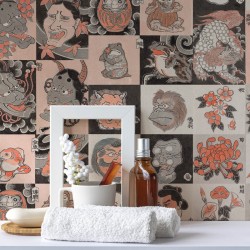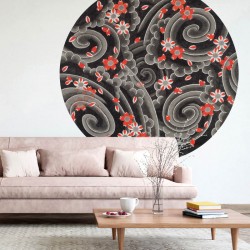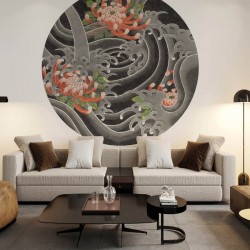These traditional Japanese tattoo motifs each have several meanings. For example the basic meaning of Koi (carp) is prosperity – bit depending on the position and combination of the motifs the meaning changes. Irezumi (刺青 - or “tattoo” in Japanese) has existed since the Edo era around 400 years ago. There are additional Japanese words similar to Irezumi such as Horimono, Shisei, Monmon and Gaman - however Irezumi is most commonly used. The literal translation of Irezumi is 刺 poke 青 blue. Traditional Japanese Sumi ink turns a beautiful blue-black color after the ink enters the skin. This product is available in different colors or sizes.
- Specifications
Premium quality heavy duty 160 grs wallpaper with paper top layer and non woven backing; Colourfast and washable with a soft cloth; No wallpapering table necessary, glue is applied to wall; Fire rating USA ASTM E 84.10 EU B.s1, do.
- Size Description
EU Roll size: W 48,7 cm x L 1000 cm = 4,87 m2
US Roll size: W 19,2" x L 393,7" = 52,42 SqFt
Repeat 448cm (176.4"), Match 23cm (9.1")
-
Kensho II
<p>Kensho Ⅱ is a Japanese tattoo master using traditional “Tebori” methods and “Sashibo”instruments. He began apprenticeship with his master Takehisa Muramatsu in 2000. Asked by Takehisa Muramatsu if he would one day like to become a tattoo artist Kesho answered “yes Sensei!” From that point his tattooing career took off. It's very difficult to be given the chance to become a tattoo apprentice in Japan, especially within a traditional Japanese tattoo family.</p> <p>The Japanese apprentice system is very strict. Takehisa Muramatsu never taught Kensho directly - Instead, he watched his technique and studied his drawings for couple years until he received permission to practice Sashibo and Tebori - but not on customers. He trained on various items such as paper, radish, banana, pig skin bought in a supermarket etc. After much practice he ultimately tried the techniques on his own skin and studied what sort of ink mixtures (Japanese traditional tattoo artists make black ink for each appointment) worked and looked better, how much force he should apply for Tebori, etc...</p>


 EUR
EUR























